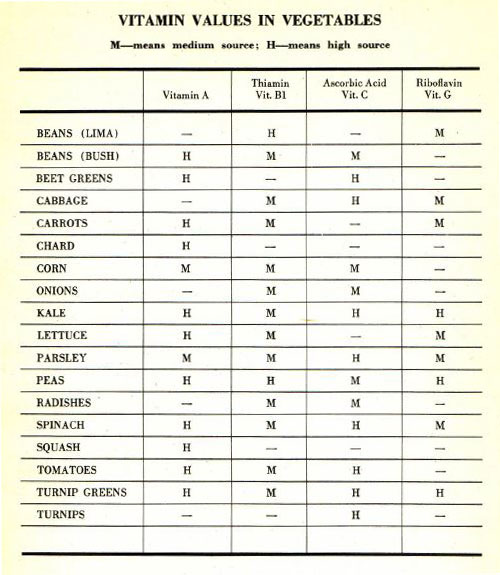I know, I’ve been on a victory garden blog post kick of late. There are a few reasons I’ve been writing about growing victory garden vegetables: first, victory gardens are the type of garden preppers should maintain; two, I love history, and victory gardens have a big place in American history; and third, victory gardens are on everyone’s mind right now with COVID-19, as evidenced by recent articles in Berkeleyside, CBS News, New York Times, and even Realtor.com.

I’m no professional gardener, but I have dug into the dirt more than once. I even built my own concrete block raised bed garden for vegetables. I’m not relying on my amateur experience for this post, however. I’m not making up this list of the best victory garden vegetables. The list comes from the WWII-era ABC of Victory Gardens pamphlet (linked to at the end of this post).
The vegetables listed below, I believe, were chosen at the time because they’re forgiving, meaning easy to grow, hearty. They are also – for the most part – vegetables that grow in abundance and come with a high nutrient and calorie count. These are also the reasons the following vegetables are great choices for a prepper’s survival garden.
24 Must-Have Victory Garden Vegetables
- Beans (BUSH) – A “must” for every garden. Great producer and easy to grow. Likes sandy loam. Sow early in May or when the soil is warm. Plant every two weeks up to August 1st for continuous supply. Rows 18″ apart. Seeds two to three inches apart and two inches deep. One packet for 25′ row. Organic Blue Lake Bush Bean Seeds
- BEANS (POLE) – Very productive! Matures later than bush beans but bear longer. Plant second week in May; not later than June 15th. Place rough 7′ poles at least 1′ in the ground about 3′ apart. Sow seeds around each pole. Thin to 3 or 4 of the strongest plants. One packet for 15 poles. Organic Kentucky Pole Bean Seeds
- BEANS (BUSH LIMAS) – One of the most succulent of all garden favorites! Likes rich sandy soil. Plant about May 15th with the eyes down in rows 2.5′ apart and seeds 5″ apart. Thin to 10″. Never cultivate or touch plants when wet. A 25′ row requires 1.5 packets. Henderson Baby Lima Bean Seeds
- BEETS – An old time favorite that requires little attention. A good storage crop for winter use. Likes a rich well-loosened sandy loam. Sow every three weeks to end of July for continuous supply. Sow seeds 1″ apart and 1″ deep in rows 18″ apart. Thin to 3″. Use tops for greens. One packet for a 25′ row. Organic Gaea’s Blessing Beets Seeds
- BROCCOLI – Start seed in a cold frame on March 15. Transplant about April 30th. For later crop, sow seeds May 30th in rows 2′ apart. Thin to 18″. Plants will continue to bear after first cutting. One packet for a 25′ row. Waltham Broccoli Seeds
- CELTUCE – Delicious as salad or cooked. Grows easily and quickly. Has four times more Vitamin C than lettuce. Use the leaves and inside meat of the stalk. Plant about April 30th in rows 2′ apart. Thin to 6″. One packet for a 25′ row. 100 Celtuce Seeds
- CARROTS – Soil must be deeply worked and loose. Sow April 15th in rows 1′ apart and 1″ deep. Thin to 3″. Sow every two weeks to July 1st for continuous supply. One packet for a 25′ row. Rainbow Blend Carrot Seeds
- CABBAGE (EARLY) – Sow seeds indoors late in February and transplant early in April, or buy plants at that time. Plant in rows 18″ apart with 18″ between plants. They like a light dry soil. Will mature in about 90 days. Cultivate lightly as roots are near surface. Early Jersey Wakefield Cabbage Seeds
- CABBAGE (LATE) – Sow this variety outdoors in May or June. Transplant in July, or buy plants at that time. This type likes heavier richer soil. Will mature in October or November. Plant in rows 2′ apart with 18″ between plants. Beware of the cabbage moth! Late Flat Dutch Cabbage Seeds
- CHARD (SWISS) – Very tasty. You can cut and it comes again and again. Many people prefer it to spinach. Plant rows 18″ apart. Thin plants to 6″. Sow in April or May. One packet for a 25′ row. David’s Garden Swiss Chard Seeds
- CORN (SWEET) – Be sure to have some if your garden is big enough. Plant May 1st to May 15th when soil is thoroughly warm. For a continuous supply, sow every two weeks until end of July. Plant in rows 3′ apart with seeds every 4″. Thin to 12″. Alternatively, plant in hills 3′ apart each way, allowing 2 or 3 plants to remain in each hill. Plant in a number of short rows instead of a few long ones, as an aid to pollination. One packet for 4 twenty-five foot rows. Peaches and Cream Sweet Corn Seeds
- KALE – It is full of vitamins and delicious when cooked. Sow seeds from April 15th to August 15th. Frost improves its flavor. Plant in rows 3′ apart. Thin or transplant the seedlings 12″ apart. One packet for a 25′ row. Curly Kale Seeds
- LETTUCE – America’s favorite salad! It’s crisp, tender, and high in vitamins and minerals. For a head start, plant seeds indoors or in a cold frame about March 1st. Transplant or sow seeds outdoors as soon as soil can be worked. Sow every two weeks until August for continuous supply. Plant in rows 12″ apart; thin to 6″. One packet will so two 50′ rows. Lettuce Lovers Seed Collection
- OKRA – A vigorous grower not found in enough gardens. Easy to grow. Young pods are delicious as cooked vegetable or for use in soups and dishes. Plant May 15th in rows 2′ apart. Thin plants to 18″. Two packets for a 25′ row. Texas Longhorn Okra Seeds
- ONIONS (SEED) – They like a well-tilled, well-drained soil. Plant as soon as ground can be worked in rows 1′ apart and 1/2″ deep. Thin to 3″ (or more if larger types are grown). Bend tops down (but don’t break off) when bulbs are full grown to hasten ripening a good crop for storage. One packet for a 25′ row. Civilys Giant Onion Seeds
- ONIONS (SETS) – These will mature much more quickly than seeds. Can be thinned out and used as scallions in about 6 weeks. Plant April 15th 2 or 3″ apart in rows 1′ apart about 1/2″ deep. One pints will do two 25′ rows. Hill Creek Evergreen Bunching Onion Seeds
- PARSNIPS – If you ever tasted tender parsnips, you would grow some most certainly. Requires a deeply worked soil. Sow about May 1st in rows 2′ apart and 1/2″ deep. Thin to 4″. Frost improves their flavor. A good crop for winter storage. One packet for a 25′ row. Organic All American Heirloom Parsnip Seeds
- PEAS – No other vegetables is so universally popular and with good reason. A freshly picked garden grown pea is unsurpassed for flavor and tenderness. Plant early in March as soon as ground can be worked. Plant in rows 2′ apart and 2″ deep. Place seeds 2″ apart. Do not thin out. Use trellis netting when seed is planted. Repeat plantings every two weeks until last May. Use 1/8 pound of seed for a 25′ row. Little Marvel Pea Seeds
- POTATOES – The gardener’s bread and butter. They like a rich sandy loam with plenty of humus. Buy good seed potatoes. Cut them nito pieces with 1 or 2 eyes. Plant April 15th in rows 30″ apart, 12″ apart, and 4″ deep. You will need about 2 lbs. for a 25′ row. White Kennebec Seed Potatoes 5 lbs
- RADISHES – They like a sandy loam but will grow well in any type. They grow quickly especially if a quick-acting fertilizer is applied. You should sow them every 2 weeks from April 15th to August 15th. Plant in rows 1′ apart 1/2″ deep. Thin to 2″. One packet for a 25′ row. Early Scarlet Globe Radish Seeds
- SPINACH – An easy crop to grow with good soil and cool weather. Plant your first crop April 15th in rows 1.5′ apart, 1/2″ deep. Thin to 5″ apart. Sow every two weeks until June 15th. Plant your seeds for a fall supply from August 15th to September 15th. One packet for a 25′ row. Gaea’s Blessing Organic Spinach Seeds
- SQUASH (BUSH) – Easy to grow and prolific. Delicious when fried, baked, or stewed. Plant in hills 3′ apart each way. Sow seeds in each hill 1″ deep. Thin to 4 of the strongest plants. One packet will do for 10 hills. Bush Baby Zucchini Summer Squash Seeds
- TOMATOES – A crop that seldom fails. It likes almost any kind of soil. You can sow seed indoors about March 15th, but most gardeners prefer to buy plants and set them out around May 15th. Plant them singly in hills at least 3′ apart each way. The tomatoes will ripen better if you tie the plants as they grow, to sturdy tomato cages. Pinch off side shoots as they appear, to make the fruit larger. Burpee Fourth of July Hybrid Seeds
- TURNIPS – A good substantial tasty dish. Hardy and easy to grow. Plant April 15th in rows 1′ apart. Thin to 4″. A grand winter storage crop. Make a 2nd planting in July or August. 1/2 packet for a 25′ row. David’s Garden Turnip Seeds
Vitamin Values Chart


If you enjoyed this post, see my related posts: What is the Best Victory Garden Size for You? and Preparing Soil for a Victory Garden. Also, feel free to download the ABC of Victory Gardens pamphlet from which most of the information in this post was derived. Thanks for reading and prep garden on!
